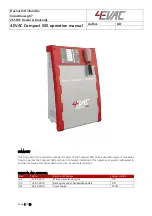
11645A
3-3
Use, Maintenance, and Care of the Devices
Visual Inspection
Visual Inspection
Examine the mating surfaces first for obvious defects or damage. If necessary, cleaning
should be done every time a connection is made. Metal particles or dirt may fall onto the
mating surface during the connection and disconnection process.
CAUTION
Devices with damaged mating surfaces should be immediately discarded or
clearly marked and set aside for repair. A damaged device will in turn
damage any good device to which it is attached. Determine the cause of the
damage before connecting a new, undamaged device in the same
configuration.
In some cases, magnification is necessary to see damage; a magnifying device with a
magnification of
≥
10
×
is recommended. However, not all defects that are visible only under
magnification will affect the electrical performance of the device. Use the following
guidelines when evaluating the integrity of a connection.
What Causes Mating Surface Wear?
Mating surface wear is caused by connecting and disconnecting the devices. The more use
a device gets, the faster it wears and degrades. The wear is greatly accelerated when
mating surfaces are not kept clean, or are not connected properly.
Mating surfacer wear eventually degrades performance of the device. Calibration devices
should have a long life if their use is on the order of a few times per week. Replace devices
with worn mating surfaces.
The test port connectors on the network analyzer test set may have many connections each
day, and are, therefore, more subject to wear. It is recommended that an adapter be used as
a test port saver to minimize the wear on the test set’s test port connectors.
Inspect the Mating Plane Surfaces
Flat contact between the mating plane surfaces is required for a good connection. Look
especially for deep scratches or dents, and for dirt and metal particles on the mating plane
surfaces. Also look for signs of damage due to excessive or uneven wear or misalignment.
Light burnishing of the mating plane surfaces is normal, and is evident as light scratches
or shallow marks distributed more or less uniformly over the mating plane surface. Other
small defects and cosmetic imperfections are also normal. None of these affect electrical or
mechanical performance. If a mating surface shows deep scratches or dents, clinging
particles, or uneven wear, clean and inspect it again.
Содержание 11645A Series
Страница 4: ...iv ...
Страница 6: ...vi 11645A Contents ...
Страница 7: ...11645A 1 1 1 General Information ...
Страница 11: ...11645A 2 1 2 Specifications ...
Страница 14: ...2 4 11645A Specifications Electrical Specifications ...
Страница 15: ...11645A 3 1 3 Use Maintenance and Care of the Devices ...
Страница 22: ...3 8 11645A Use Maintenance and Care of the Devices Handling and Storage ...
Страница 23: ...11645A 4 1 4 Performance Verification ...
Страница 26: ...4 4 11645A Performance Verification Recertification ...
Страница 27: ...11645A 5 1 5 Troubleshooting ...
Страница 29: ...11645A 5 3 Troubleshooting Troubleshooting Process Figure 5 1 Troubleshooting Flowchart ...
Страница 32: ...5 6 11645A Troubleshooting Contacting Agilent ...
Страница 33: ...11645A 6 1 6 Replaceable Parts ...
Страница 35: ...11645A 6 3 Replaceable Parts Introduction Figure 6 1 R Band Component Identification Sheet ...
Страница 37: ...11645A 6 5 Replaceable Parts Introduction Figure 6 2 Q Band Component Identification Sheet ...
Страница 39: ...11645A 6 7 Replaceable Parts Introduction Figure 6 3 U Band Component Identification Sheet ...
Страница 41: ...11645A 6 9 Replaceable Parts Introduction Figure 6 4 V Band Component Identification Sheet ...
Страница 43: ...11645A 6 11 Replaceable Parts Introduction Figure 6 5 W Band Component Identification Sheet ...
















































